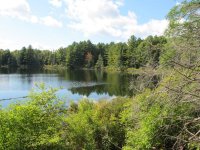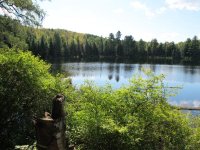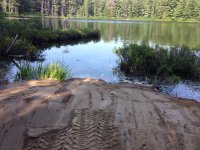the bottom of a pond / lake = a septic tank. no way around it. it is a septic tank. by providing water currents that bring in higher DO (dissolved oxygen) level to the muck layer. you can help increase various bacteria, single cell organisms, etc... to help break down the ugly stinky mess on the bottom of the lake.
there are a variety of septic systems out there. what is mostly seen on homes. is all your poo goes to a large tank, and over time bacteria / single cell organisms break stuff down. ((anaerobic)) all the stuff that breaks it down, does not need oxygen.
another type, (i forget all the key terms), i want to call active, were you introduce bubbles, or a water pump. (primary goal) is to increase the DO (dissolved oxygen level) and to bring that enriched water into more contact with the muck. ((aerobic)) these bacteria / single cell organisms can break down the muck much faster. part of breaking down muck is also (off gassing) basically water picks up some nasty stuff, and as the water comes in contact with the air, it can release the nasty stuff into the air.
there is another type of filtration, that goes more directly to converting muck directly to stuff that can be off-gassed more directly but that is something else entirely.
=========
you are more likely to see an "aerobic" septic setup, on say a restaurant. vs some residential home. this is due to amount of overall organic crud going into the septic system (organic crud = all the food waste coming off folks plates when washing dishes) not to mention more folks using the bathroom more often.
==========
the air bubblers. are not the key thing. yes the help raise DO (dissolved oxygen) level. but not that much. it is the water currents that help bring higher DO water into contact with the muck layer in the bottom of the pond/lake. and then also bring that same water back up to pond/lake surface to off gas some stuff.
breaking down the muck layer does not happen over night, it takes time for bacteria / single cell organisms and like to break down the muck layer. it can easily take roughly 90 days for initial "aerobic" bacteria / single cell organisms to start taking hold. and then it may take 2 to 4 years for it to have a large overall benefit to the pond / lake. as things begin to break down.
the goal of adding air bubbler, or surface agitation, or other. is to change the system from an "anaerobic" (no oxygen) system to an "aerobic" system (relies more on more oxygen in the water).
==========
regardless of what you do... you will still have "thick mud" at the beach, granted goal is to help remove the "black sewer mud" and turn it into less nasty stinky mud.
doing above will help remove stuff for plants to grow. (removing nutrients) for the plants / vegetation / weeds.
the issue is... no matter what you do. plants will continue to grow. plants tend to grow 4feet deep and shallower. ((sun rays have a harder time penetrating deeper into the water past 4 feet)) but the plants should end up getting nocked back a descent amount (within reason)
i might encourage a "floating dock" or floating ramp, so you can get folks out past 4 to 5 feet depth. so they can climb up and down a ladder, without walking through the muck and weeds. this will more likely ensure those "city slickers" will go out into the water. vs giving you the ugly face because they need to walk through mud / weeds, and refuse to go out.
if you can lay some plastic or like down in the water. and over the muck. you might have something. no need to put anything on top of it. just make sure it is non see through and UV resistant. a WARNING plastic down below water = dangerous. once algae grows on it, and it will. it will make the plastic slicker than snot. and you will fall right on your rear and under water before you realized it. adding some sort of sand or like on top of the plastic = a place for weeds and like to begin to grow. (your are darned if you do, and darned if you do not).
--if you can get ahold of some thicker plastic, example pond liner (epdm or pvc or like) generally the thicker stuff when you go out and walk on it, your foot / toes will not puncture it as you walk over softer mud under it. have went through enough beaches, were they put down cheapest plastic they could find, and end up tripping / stubbing my feet into ripped up plastic under the water. hopefully with a thicker plastic, you will be able to say take a metal garden rake, and sweep across some sand placed on top of the plastic. to remove weeds / vegetation, without putting holes in the plastic.


